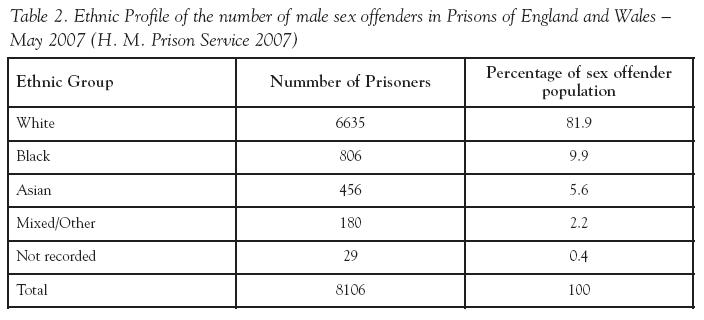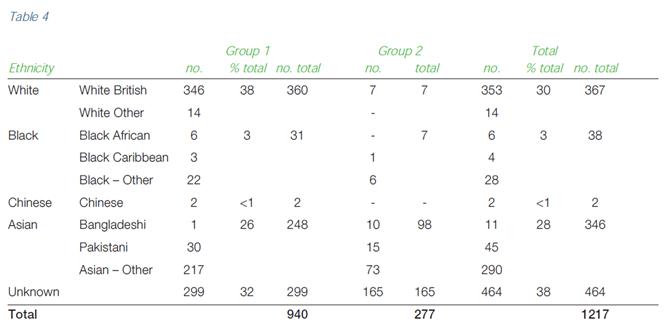Are Asians disproportionately represented in prosecutions for sex offences?
This article has been updated.
"Sex offenders are actually overwhelmingly white"
"There is very troubling evidence that Asians are overwhelmingly represented in prosecutions [of street grooming offences]."
Martin Narey, BBC Today Programme, 9 May 2012
Join 72,953 people who trust us to check the facts
Sign up to get weekly updates on politics, immigration, health and more.
Subscribe to weekly email newsletters from Full Fact for updates on politics, immigration, health and more. Our fact checks are free to read but not to produce, so you will also get occasional emails about fundraising and other ways you can help. You can unsubscribe at any time. For more information about how we use your data see our Privacy Policy.
"20 per cent of the perpetrators of grooming were identified as people of Asian origin. 38 per cent were white. And 32 per cent the ethnicity was unknown"
Keith Vaz, BBC Today Programme, 9 May 2012
A great deal of media focus has been given recently to the conviction of nine men at the Liverpool Crown Court, found guilty of offences including rape and conspiracy to engage in sexual activity with a child.
On Wednesday morning Keith Vaz, the Labour MP and Chairman of the Home Affairs Select Committee, debated with former Head of the Prison Service and former Barnado's Chief Martin Narey.
Mr Narey posited that sex offenders were "overwhelmingly white", but for the particular offence of street grooming "there is very troubling evidence that Asians are overwhelmingly represented in the prosecutions".
Mr Vaz went on to state his support for the Child Exploitation and Online Protection organisation (CEOP) as a reliable source of information, citing their "very clear" research which indicates that one in five perpetrators of grooming were identified as people of Asian origin.
Overwhelmingly White?
Martin Narey's first claim was that sex offenders are 'overwhelmingly white'. Full Fact contacted Mr Narey for the source he was using, and we're waiting for his response. However the HM Prison Service's ethnic profile statistics can offer some insight.
While these haven't been published in any comprehensive format, they have been used in a number of academic studies. Sheffield Hallam University provides one snapshot of the ethnic profile of male sex offenders in England and Wales for 2007:

Given that the vast majority of prisoners in the UK are male, this is a reasonable, though not exact, indicator of the overall proportion of offenders who are of 'white' ethnicity.
The data suggests that the proportion of offenders who are white could well be described as 'overwhelming'. If Mr Narey is able to provide more recent data we will have a clearer idea of whether or not this proportion has changed significantly since 2007.
What about Grooming?
Keith Vaz's figures on the ethnicity of those convicted of grooming are taken from the Child Exploitation and Online Protection Centre (CEOP). Their report 'Out of Mind, Out of Sight' from June 2011 contains relevant figures on 'Localised Grooming':
"This is a form of sexual exploitation, previously referred to as 'on street grooming' in the media, where children have been groomed and sexually exploited by an offender, having initially met in a location outside their home, usually in a public place (such as a park, cinema, on the street or at a friend's house)."
The information collected covered the period between 01 January 2008 to 01 March 2011. CEOP grouped offenders in two categories according to how much information was available about the individual. The first category, 'group 1' contained detailed information on the ethnicity of the perpetrators, while 'group 2' had only limited information associated with them.
Information gathered from the two groups is presented in the table below:

Among the group providing complete details, 38 per cent were white, 26 per cent Asian and 32 per cent were 'unknown'. Mr Vaz quoted the White and unknown categories correctly, but appears to understate the proportion defined as Asian (he referred to '20 per cent').
But this also excludes the offenders in 'group 2', for whom more data - albeit limited - was provided. Including these increases the proportion of offenders who were Asian and decreases the proportion who were White, which could dilute Mr Vaz's point.
The data nevertheless still serves to support Mr Narey's point that Asians are 'overwhelmingly represented' in such prosecutions, due to the fact that only 6 per cent of the English population is classed as 'Asian', according to the Office for National Statistics. (It appears the CEOP report covers the whole of the UK, so the figures may not be directly comparable.)
But is the data reliable?
The report itself took care to express concerns over its own conclusions. Due to the manner in which it collected the data CEOP stated that it could not be considered a comprehensive assessment.
The report is based on information that was gathered from various sources, including: 46 police forces, 22 children's services and LSCBs (including nine responses from children's services, 4 responses from LSCBs, and nine joint responses from children's services and LSCBs) and 12 specialist service providers from the voluntary sector. As a result, it is not a comprehensive picture, as the report itself notes:
"This assessment cannot be seen as fully representative of the nature and scale of child sexual exploitation in the U.K., or, indeed, of the 'localised grooming' model."
In particular, the report raises concerns over its ethnic representation:
"Caution should be taken in drawing conclusions about ethnicity due to the relatively small number of areas where agencies have been proactive around this particular type of crime. We do not draw national conclusions about ethnicity from the data available at this time because it is too inconsistent."
When contacted, the CEOP stated that the figures cannot be considered as absolute fact: CEOP did not receive responses from all police forces and NGOs, and they point out that the report can only be as good as the information given.
Conclusion
We therefore need to be cautious about Keith Vaz's claim, as the source he uses explicitly warns against drawing any nationwide conclusions on the basis of its research.
While both the HM Prison Service and CEOP datasets have problems associated with them, there is nevertheless some evidence to suggest that sex offenders are 'overwhelmingly white' in terms of the raw numbers.
However while just under 82 per cent of inmates incarcerated for sex offences in 2007 were classified as white, this was actually lower than the overall proportion of the population that were similarly classed, which stands at 87.5 per cent (for England). At six per cent, the proportion of sex offenders in custody that were classed as Asian almost exactly matches the proportion of the population classed similarly.
Looking at grooming offences collected by the CEOP, while the white ethnic group makes up the largest proprotion of all offenders, it is far below the proportion of white people in the general population. Meanwhile, those of Asian origin are indeed disproportionately represented here.
Update (10/5/2012): The Ministry of Justice has provided us with more up-to-date figures on the sentencing for sex offences by ethnicity. These cover all sex offences sentenced at either crown or magistrates' courts in 2010, and show similar figures to the 2007: around 78 per cent of offenders were white, while 8 per cent were Asian (full data here).